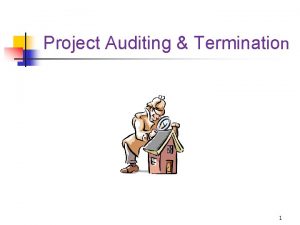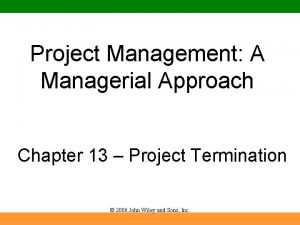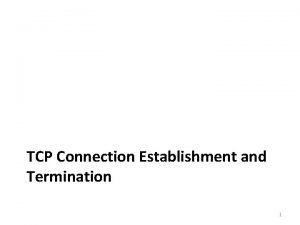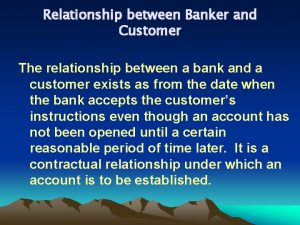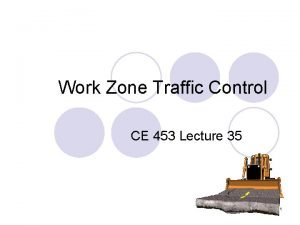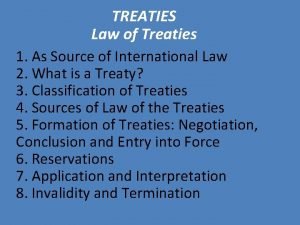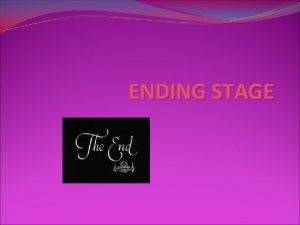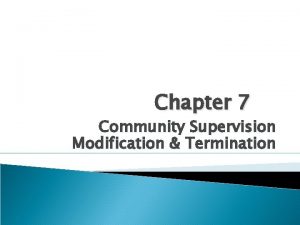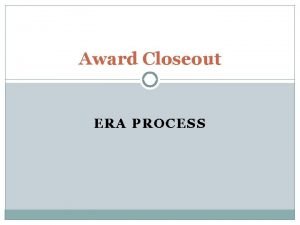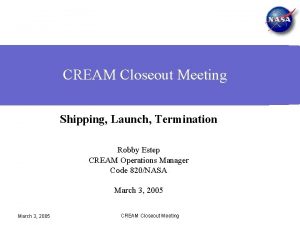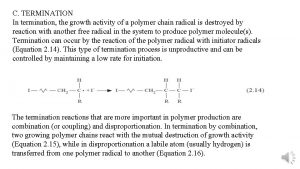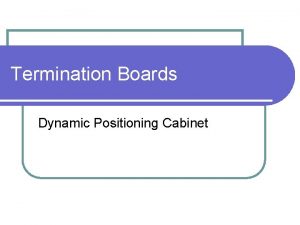Chapter 14 Project Closeout and Termination 14 01



















- Slides: 19

Chapter 14 Project Closeout and Termination 14 -01

Chapter 14 Learning Objectives After completing this chapter, students will be able to: �Distinguish among the four main forms of project management. �Recognize the seven steps in formal project closeout. �Understand key reasons for early termination of projects. �Know the challenges and components of a final project report. Copyright © 2013 Pearson Education, Inc. Publishing as Prentice Hall 14 -02

Project Termination All activities consistent with closing out the project v. Extinction v. Addition v. Integration v. Starvation Copyright © 2013 Pearson Education, Inc. Publishing as Prentice Hall 14 -03

Elements of Project Closeout Management Harvesting Gaining Finishing Handing Acceptance the Benefits Over the The Work Product for the Reviewing Product How It All Went Putting it All to Bed Disbanding the Team Copyright © 2013 Pearson Education, Inc. Publishing as Prentice Hall 14 -04

Lessons Learned Meetings Common Errors ØMisidentifying systematic errors ØMisinterpreting lessons based on events ØFailure to pass along conclusions Meeting Guidelines üEstablish clear rules of behavior üDescribe objectively what occurred üFix the problem, not the blame Copyright © 2013 Pearson Education, Inc. Publishing as Prentice Hall 14 -05

Closeout Paperwork Documentation Legal Cost Personnel Copyright © 2013 Pearson Education, Inc. Publishing as Prentice Hall 14 -06

Why are Closeouts Difficult? üProject sign off can be a de-motivator üConstraints cause shortcuts on back-end üLow priority activities üLessons learned analysis seen as bookkeeping üUnique view of projects Copyright © 2013 Pearson Education, Inc. Publishing as Prentice Hall 14 -07

Early Warning Signs of Project Failure Lack of viable commercial objectives Lack of sufficient authority to make decisions New product developed for stable market Low priority assigned to the project by management Copyright © 2013 Pearson Education, Inc. Publishing as Prentice Hall 14 -08

Dynamic Factors to Monitor 1. Static 2. Task-team 3. Sponsorship 4. Economics 5. Environment 6. User Copyright © 2013 Pearson Education, Inc. Publishing as Prentice Hall 14 -9

Early Termination Decision Rules § Costs exceed business benefits § Failure to meet strategic fit criteria § Deadlines continue to be missed § Technology evolves beyond the project’s scope Copyright © 2013 Pearson Education, Inc. Publishing as Prentice Hall 14 -10

The Top 10 Signs of IT Project Failure 10. Best practices and lessons learned are ignored 9. Project lacks people with appropriate skills 8. Sponsorship is lost 7. Users are resistant 6. Deadlines are unrealistic 5. Business needs change 4. Chosen technology changes 3. Project changes are poorly managed 2. Scope is ill-defined 1. Project managers don’t understand users’ needs Copyright © 2013 Pearson Education, Inc. Publishing as Prentice Hall 14 -11

Project Termination Issues Emotional Staff Client Copyright © 2013 Pearson Education, Inc. Publishing as Prentice Hall Intellectual Internal External 14 -12

Project Termination Issues - Emotional Staff Fear of no future work Client Change in attitude Loss of interest in remaining tasks Loss of interest in project Loss of project-derived motivation Change in personnel dealing with project Loss of team identity Unavailability of key personnel Selection of personnel to be reassigned Diversion of effort Copyright © 2013 Pearson Education, Inc. Publishing as Prentice Hall 14 -13

Project Termination Issues – Intellectual Internal External Identification of remaining deliverables Agreement with client on remaining deliverables Certification needs Agreement with suppliers on outstanding commitments Identification of outstanding commitments Communicating closure Control of changes to project Closing down facilities Screening of partially completed tasks Determination of requirements for audit trail data Closure of work orders and work packages Disposal of unused material Copyright © 2013 Pearson Education, Inc. Publishing as Prentice Hall 14 -14

Claims & Disputes Two types of claims Ex-gratia claims Default by the project company Resolved by Arbitration Binding Non-binding Standard litigation Copyright © 2013 Pearson Education, Inc. Publishing as Prentice Hall 14 -15

Protecting Against Claims o Consider claims as part of the project plan o Verify stakeholders know their risks o Keep good records throughout the life cycle o Keep clear details of change orders o Archive all correspondence Copyright © 2013 Pearson Education, Inc. Publishing as Prentice Hall 14 -16

Final Report Elements q. Project performance q. Administrative performance q. Organizational structure q. Team performance q. Project management techniques q. Benefits to the organization and customer Copyright © 2013 Pearson Education, Inc. Publishing as Prentice Hall 14 -17

Summary 1. Distinguish among the four main forms of project management. 2. Recognize the seven steps in formal project closeout. 3. Understand key reasons for early termination of projects. 4. Know the challenges and components of a final project report. Copyright © 2013 Pearson Education, Inc. Publishing as Prentice Hall 14 -18

Copyright © 2013 Pearson Education, Inc. Publishing as Prentice Hall 14 -19
 Project close out
Project close out Project closeout presentation
Project closeout presentation Project evaluation and control
Project evaluation and control Types of terminations
Types of terminations Contract closeout
Contract closeout Quick closeout procedures
Quick closeout procedures Demobilization plan sample
Demobilization plan sample Transfer of command
Transfer of command Project audit life cycle
Project audit life cycle Project termination by extinction
Project termination by extinction Project termination
Project termination Connection establishment and termination
Connection establishment and termination In file organization a fixed format is used for records
In file organization a fixed format is used for records Contract between banker and customer
Contract between banker and customer Termination area mutcd
Termination area mutcd Termination of treaties
Termination of treaties Intake interview adalah
Intake interview adalah Voluntary termination
Voluntary termination Ending stage
Ending stage Femoral canal and femoral sheath
Femoral canal and femoral sheath








